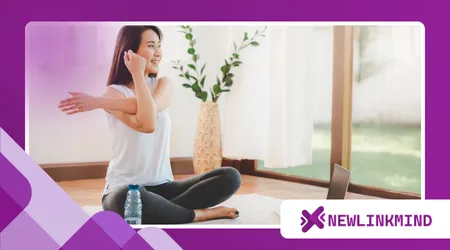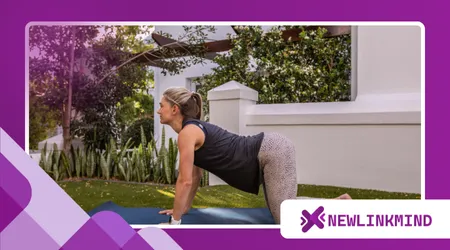How to Prevent Injury While Doing Yoga at Home

Anúncios
Prevent Injury While Doing Yoga at Home. The rise of at-home yoga has democratized wellness, bringing the profound benefits of this ancient practice to our living rooms.
While the convenience is unparalleled, it presents a unique challenge: the absence of an instructor to guide your form and correct your alignment.
Therefore, it’s more critical than ever to learn how to Prevent Injury While Doing Yoga at Home.
This is not about fear, but about empowerment—understanding your body and your practice so you can build a sustainable, lifelong relationship with yoga.
Listening to Your Body’s Whispers, Not Its Screams
Imagine your body is a sophisticated car. Just as a small red light on the dashboard signals a potential issue, your body communicates through sensations.
Anúncios
A healthy stretch, for instance, feels like an expansive lengthening, a gentle pull. Pain, conversely, is sharp, stinging, or a deep ache.
Learning to differentiate these signals is perhaps the most valuable skill a home practitioner can develop.
Never push through sharp pain, regardless of how a pose “should” look. Your body’s integrity is far more important than achieving a perfect form.
Anúncios
The Unwavering Importance of Alignment
Proper alignment is the bedrock of a safe yoga practice. Without it, you’re simply building a house on a shaky foundation.
Incorrect form places undue stress on joints, ligaments, and muscles, leading to chronic issues. The key is to start with the fundamentals and build from there.
Read more: Yoga with Pets: How to Include Your Dog or Cat in Practice
For example, in Downward-Facing Dog, your hands should be shoulder-width apart, and your feet hip-width apart. This simple alignment protects your wrists and shoulders.

The American Council on Exercise (ACE) reported in 2024 that improper form is a leading cause of yoga-related injuries, a statistic that underscores the need for self-awareness and education.
| Common Pose | Incorrect Alignment Risk | Safe Alignment Practice |
| Warrior I | Knee extends past ankle | Align knee directly over ankle |
| Chaturanga | Shoulders dip below elbows | Keep elbows tucked to sides, body straight |
| Triangle Pose | Hips not stacked | Hips stacked, open torso to side |
| Cobra Pose | Clamping lumbar spine | Engage core, lift with back muscles |
Don’t Skip the Warm-Up
A yoga session is not like a light stroll; it is a physical discipline that requires preparation. Ignoring a warm-up is like trying to mold cold clay—it will crack and break.
A proper warm-up increases blood flow to muscles, making them more pliable and less prone to strains.
See how interesting: How to Host a Group Meditation at the Office
It doesn’t have to be long, just a few minutes of cat-cow, gentle twists, and sun salutations.
Even a short ten-minute flow before a more intense practice can significantly Prevent Injury While Doing Yoga at Home.
The Power of Props and Pacing
Don’t view props like blocks or straps as a sign of weakness; they are tools for progress and safety.
A block under your hand in Triangle Pose allows you to maintain a straight spine, preventing rounding and strain on your hamstrings.
Likewise, a strap can help you access a deeper stretch in a seated forward fold without compromising your back.
Rushing into advanced poses is a recipe for disaster. Think of your practice as a marathon, not a sprint.
Take the time to build strength and flexibility gradually, and you will reap the rewards for years to come.
One common mistake is when a student attempts a full Wheel Pose before their shoulders and spine have the necessary mobility.
A safer approach would be to start with Bridge Pose, slowly building strength and flexibility over weeks or months.
The Essential Post-Practice Rituals
Your practice doesn’t end when you roll up your mat. The cool-down is just as vital as the warm-up.
Taking a few minutes to stretch your hamstrings, hips, and shoulders after a strong flow helps release tension and prevent muscle soreness.
Check this out: How to Avoid Falling Asleep During Morning Meditation
Savasana, or Corpse Pose, at the very end is non-negotiable. It allows your nervous system to rest and integrate the benefits of your practice.
This period of rest is crucial. For example, after a vigorous vinyasa session, a long, gentle hamstring stretch and a spinal twist will help restore your muscles, leaving you feeling balanced and refreshed.
This simple habit will help you Prevent Injury While Doing Yoga at Home.

Cultivating a Mindful Environment
Your practice space should be a sanctuary, not an obstacle course.
Ensure your mat is on a non-slip surface and that there is ample room to move freely without bumping into furniture.
Make sure you have enough light, but not so much that it causes a glare or is distracting. A well-organized, clean space allows you to focus solely on your body and breath.
Creating this dedicated area is a proactive step to Prevent Injury While Doing Yoga at Home and fosters a more consistent and enjoyable practice.
The Final Word on Your Yoga Journey
Ultimately, your home practice is a personal journey of self-discovery.
By listening to your body, respecting your limits, and using the right tools, you can ensure that this journey is long and rewarding.
The goal isn’t to master a pose but to understand your body better. Can you truly say you’re listening to your body if you’re pushing it past its natural limits every single day?
Remember, a safe practice is a sustainable practice.
By following these guidelines, you will Prevent Injury While Doing Yoga at Home and cultivate a deep, meaningful relationship with your body.
A mindful approach to your practice is the ultimate form of self-care.
Frequently Asked Questions
What if I don’t have props?
You don’t need fancy equipment. Books can be used as blocks, and a belt or towel can substitute for a strap. Be creative and resourceful.
How often should I practice to avoid injury?
Consistency is key. It’s better to practice for 15-20 minutes daily than for one hour once a week. This allows your body to build strength and flexibility gradually.
Is it okay to use YouTube videos for guidance?
Yes, but choose wisely. Look for certified instructors with clear alignment cues.
You can also pause the video to check your form in the mirror or against the instructor’s posture. This allows you to better Prevent Injury While Doing Yoga at Home.
How do I know if I’m pushing too hard?
If you feel a sharp, shooting pain, or a sudden strain, you’ve gone too far. Back off immediately.
Also, if your breath becomes strained or you start to hold your breath, it’s a sign to ease up on the intensity.
Should I practice when I’m tired or sore?
On days when you’re tired, opt for a gentler, more restorative practice. The goal isn’t to be a hero; it’s to be consistent and kind to your body.
Learning to modify your practice based on how you feel is one of the best ways to Prevent Injury While Doing Yoga at Home.
++ The Art of Alignment: Top Tips to Prevent Common Yoga Injuries
++ 6 Essential Tips to Safely Enhance Your Yoga Training and Prevent Injuries
